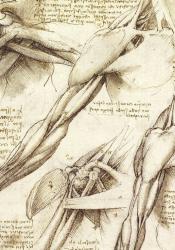Leonardo’s Autopsy Studies
Leonardo Da-Vinci was well versed in many disciplines including anatomy and physiology. At the age of 20 he conducted his first post-mortem autopsy which he was granted with special permission due to being an artist. It is not rare for artists to perform autopsy studies but Da Vinci researched further into anatomy than most other artists by becoming interested in internal organs and not just muscle structure. Da vinci studied joints, movement, organs, bones, disease, body proportion, and many many other features of the human body. His study of body movement, muscles, and joints were for artistic purposes; to properly convey a motion or structure to the figures in his paintings. The rest of his studies were mostly for exploration and discovery about the human body. Da Vinci would complete around 30 human dissections over the course of his lifetime and many animal dissections. Along with these dissections he would also accumulate a vast amount of extremely detailed drawings of the anatomy he observed.
Sources:
Keele, Kenneth D. Leonardo Da Vinci’s Influence on Renaissance Anatomy. Medical History 1964. Vol 8 (4): 360-370. Print.
Sterpetti, Antonio V. Anatomy and physiology by Leonardo: The hidden revolution?. Surgery 2016. Vol 159 (3): 675-687. DOI:https://doi.org/10.1016/j.surg.2015.10.001. Accessed March 8, 2018.
Sterpetti, Antonio V. The Revolutionary studies by Leonardo on blood circulation were too advanced for his time to be published. Journal of Vascular Surgery 2015, vol 62 (1): 259-263. DOI:https://doi.org/10.1016/j.surg.2015.10.001 . Accessed March 8, 2018.
Image Source:
Sterpetti, Antonio V. Anatomy and physiology by Leonardo: The hidden revolution?. Surgery 2016. Vol 159 (3): 675-687. DOI:https://doi.org/10.1016/j.surg.2015.10.001. Accessed March 8, 2018.

